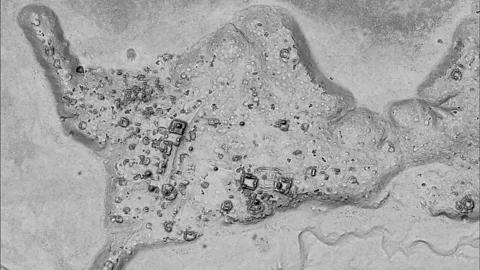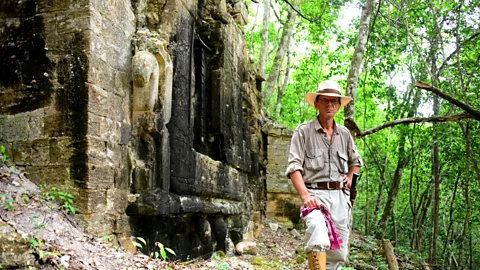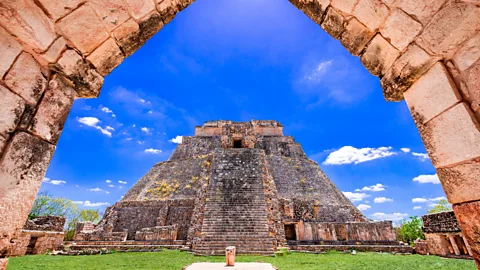Ocomtún: A long-lost Maya city that was just discovered
 ZRC SAZU
ZRC SAZUArchaeologist Ivan Šprajc has spent nearly 30 years uncovering long-lost cities buried deep in Mexico's Yucatán Peninsula. His latest discovery is capturing the world's attention.
"You need to be a little crazy for this work," said Dr Ivan Šprajc, taking a drag of his cigarette and staring at me with ice-blue eyes. "You have to be careful about the snakes, insects, jaguars and everything else. But there is something pushing us. You have to suffer a little if you want to find something that few people have ever seen that was hidden for so many centuries."
Once described by The Guardian as "the real-life Indiana Jones", Šprajc has spent nearly 30 years hacking his way through the remote tangles of Mexico's Yucatán Peninsula to find long-lost Maya cities buried deep in the jungle.
In 2013, the Slovenian archaeologist and his team unearthed a previously unknown 40,000-person city dating to the 8th Century that had been swallowed by the rainforest called Chactún. A year later, they located two more Maya cities – Lagunita and Tamchén – which each featured pyramid temples, plazas and intricately carved stele that seemed to have been mysteriously abandoned around 1,200 years ago.
 Mauricio Marat, INAH, Mexico
Mauricio Marat, INAH, MexicoYet, it is Šprajc's latest discovery that is now drawing worldwide attention.
Late last month, the archaeologist and his team located the remains of an ancient, abandoned Maya city home to numerous pyramid-shaped structures rising more than 15m nestled deep within Mexico's Balamkú Ecological Conservation Zone. He named the site Ocomtún ("stone column" in Yucatec Mayan) after the many cylindrical columns also scattered throughout the settlement. Pottery examined from the site indicates it was likely inhabited between 600 and 800 CE.
"These cities had been lost to time. Nobody knew exactly where they were" Šprajc told BBC Travel in his first interview since Ocomtún's discovery. "But this [Ocomtún], was actually the last major black hole on the archaeological map of the central Maya Lowlands (the modern-day central Yucatán Peninsula). Nothing was there. There was not a single known site in an area stretching some 3,000-4,000 sq km."
Mapping this previously uncharted black hole could shed more light on who the Maya were, and what may have led to their dramatic collapse.
 Alpineguide/Alamy
Alpineguide/AlamyThe great Maya mystery
Commonly considered one of the greatest civilisations in the Western Hemisphere, the Maya ruled over much of Central America during their peak between 200-900 CE. Perhaps best known for their towering pyramid temples and more than 40 grand cities carved out of stone – such as Tikal, Uaxactún and Copán – the Maya were also obsessive astronomers, brilliant mathematicians and prolific scribes.
Šprajc's favourite Maya sites
• Palenque – "one of the most beautiful and famous Maya sites"
• Tikal – "a gem that should be known and visited"
• Calakmul – "If you want to see a Maya site in a virgin state, go here. You can climb one of the two biggest pyramids and all you'll see is green jungle. It was a famous rival of Tikal with 120 stele monuments. Tikal only has 40."
They kept detailed records of eclipses and solstices and aligned their cities' most important structures to the celestial movements. They invented the concept of zero roughly 1,000 years before Europeans and developed a calendar in the 1st Century BCE that was more accurate than the Julian calendar used across the UK, Europe and Asia for the next 1,700-2,000 years. They were one of the world's earliest civilisations to devise a system of writing (as early as 300 BCE) and went on to create thousands of paper books. They likely invented chocolate, the world's first ball game and rubber.
"There has always been a fascination around the Maya," Šprajc said. "Most of these wonderful cities have been found deep in the forest, so it has kind of been an enigma: how can a civilisation emerge and flourish in a tropical environment">window._taboola = window._taboola || []; _taboola.push({ mode: 'alternating-thumbnails-a', container: 'taboola-below-article', placement: 'Below Article', target_type: 'mix' });
